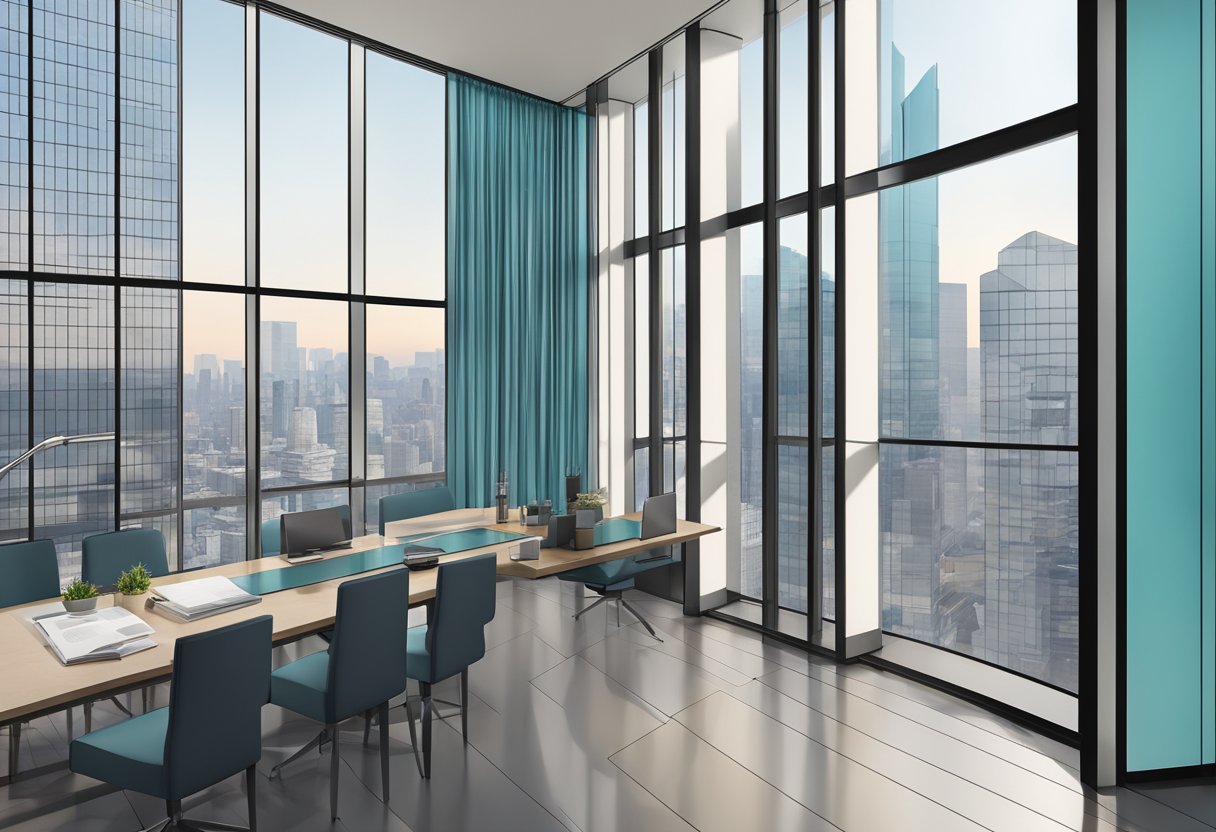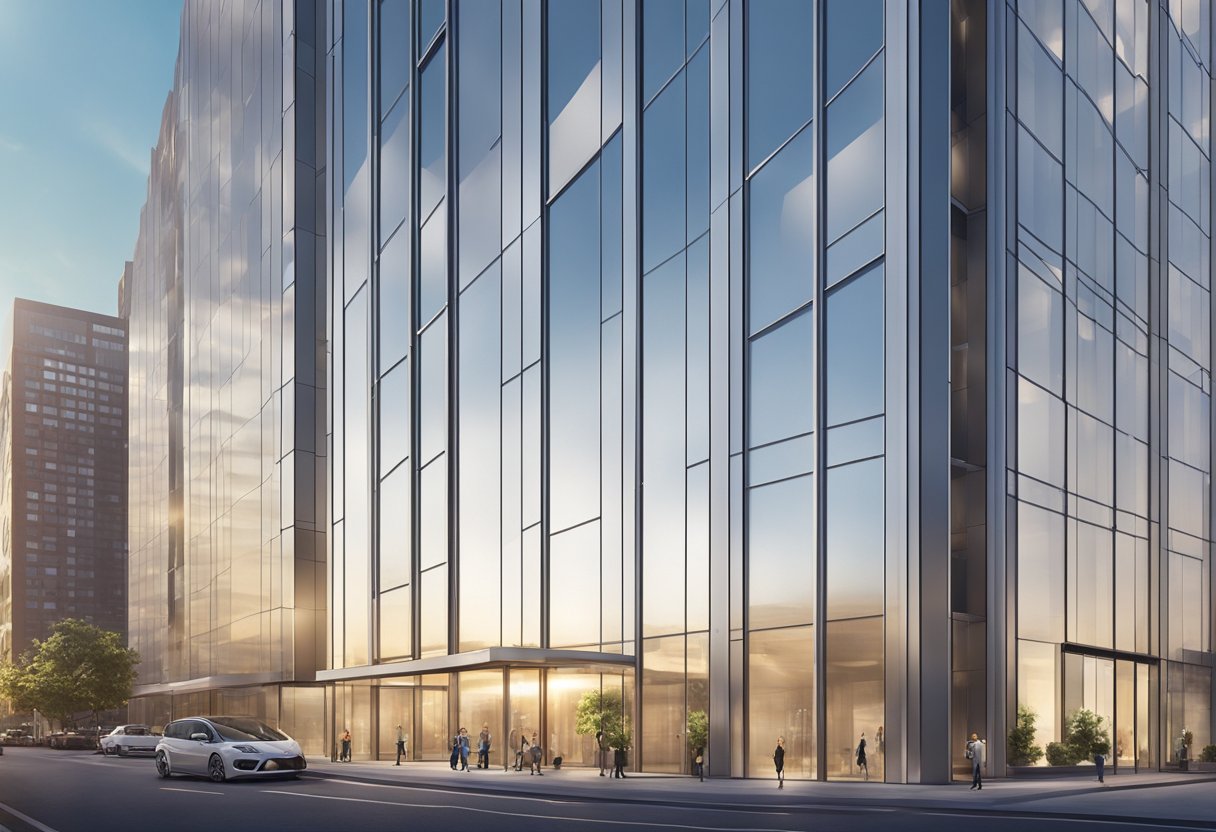Aluminum panel curtain wall is a popular building material used in modern construction. It is a type of facade system that consists of panels made of aluminum alloy, which are attached to a building’s structural frame. The panels are designed to provide an aesthetically pleasing appearance while also offering functionality and durability.

One of the main benefits of aluminum panel curtain wall is its versatility. It can be used in a variety of applications, including high-rise buildings, commercial buildings, and residential buildings. The panels can be customized to meet the specific design requirements of each project, allowing architects and designers to create unique and visually stunning facades.
In addition to its aesthetic appeal, aluminum panel curtain wall offers a number of other advantages. It is lightweight, which makes it easier and more cost-effective to transport and install. It is also highly durable and resistant to corrosion, making it a low-maintenance option for building exteriors. Overall, aluminum panel curtain wall is a reliable and efficient choice for modern construction projects.
History of Aluminum Panel Curtain Walls

Aluminum panel curtain walls have been used in building construction for over 50 years. The development of these walls came about as a result of the need for a lightweight, durable, and low-maintenance building material that could withstand the harsh environmental conditions of modern cities.
The first aluminum panel curtain walls were developed in the 1960s and were primarily used in commercial buildings. These walls were made up of aluminum panels that were attached to a structural frame using a variety of different methods, including adhesive bonding, mechanical fastening, and welding.
Over time, the design and construction of aluminum panel curtain walls have evolved to include a variety of different features, such as thermal insulation, sound insulation, and fire resistance. Today, aluminum panel curtain walls are used in a wide range of building applications, from commercial and residential buildings to healthcare facilities and educational institutions.
One of the main advantages of aluminum panel curtain walls is their versatility. These walls can be customized to meet the specific needs of each building project, including size, shape, color, and texture. Additionally, aluminum panel curtain walls are highly durable and require minimal maintenance, making them a cost-effective choice for building owners and developers.
Overall, the history of aluminum panel curtain walls is a testament to the ongoing innovation and evolution of building materials and construction techniques. As technology continues to advance, it is likely that we will see even more advanced and sophisticated aluminum panel curtain walls being developed in the years to come.
Design and Aesthetics
Material Properties
Aluminum panel curtain walls are a popular choice for modern building design due to their lightweight and durable properties. Aluminum is a non-corrosive metal, which makes it ideal for use in outdoor applications. The panels are available in a range of thicknesses and finishes, allowing architects to create unique designs that meet their clients’ needs.
One of the benefits of using aluminum panels is that they are easy to install and require minimal maintenance. Additionally, the panels can be easily replaced if they become damaged or outdated. This makes them a cost-effective option for building owners who want to update the appearance of their property.
Architectural Styles
Aluminum panel curtain walls can be used in a variety of architectural styles, from modern and minimalist to more traditional designs. The panels can be customized to match the color and texture of the surrounding building materials, allowing architects to create a seamless look.
One of the benefits of using aluminum panels is that they can be cut into different shapes and sizes, allowing architects to create unique designs. This flexibility in design makes aluminum panel curtain walls a popular choice for architects who want to create a building that stands out from the crowd.
In conclusion, aluminum panel curtain walls are a versatile option for building design. They offer a range of benefits, including durability, flexibility in design, and ease of maintenance. Architects can use aluminum panels to create buildings that are both functional and aesthetically pleasing.
Manufacturing Process
Raw Material Selection
The first step in the manufacturing process of aluminum panel curtain wall is the selection of raw materials. The raw materials used for the fabrication of these panels are aluminum sheets, which are available in a variety of alloys and thicknesses. The selection of the appropriate alloy and thickness depends on the specific requirements of the project.
The most commonly used aluminum alloys for panel curtain walls are 3003, 5052, and 6061. These alloys are chosen for their strength, durability, and corrosion resistance. The thickness of the aluminum sheets used for the panels typically ranges from 1.5mm to 4mm.
Fabrication Techniques
Once the raw materials have been selected, the fabrication process begins. The fabrication of aluminum panel curtain wall involves several techniques, including cutting, bending, welding, and painting.
The first step in the fabrication process is cutting the aluminum sheets to the required size. This is done using a shear or a CNC cutting machine. The sheets are then bent to the required shape using a press brake.
The next step is welding the panels together. This is done using a variety of welding techniques, including TIG, MIG, and spot welding. The welding process is critical to the strength and durability of the panels.
Finally, the panels are painted using a powder coating process. This process involves applying a dry powder to the surface of the panels and then baking them in an oven to create a durable and long-lasting finish.
Overall, the manufacturing process of aluminum panel curtain wall involves a combination of precision cutting, bending, welding, and painting techniques to create a high-quality and durable product.
Installation and Implementation
Mounting Systems
Aluminum panel curtain walls are installed using various mounting systems, including stick-built, unitized, and semi-unitized systems. Stick-built systems involve assembling the curtain wall on-site, while unitized and semi-unitized systems are pre-fabricated in a factory and then transported to the construction site for installation.
The mounting system used will depend on the specific project requirements, such as the building height, wind loads, and seismic activity. The mounting system must be designed to withstand these loads and ensure the stability and safety of the curtain wall.
Sealing and Waterproofing
Sealing and waterproofing are critical components of aluminum panel curtain wall installation. The joints between panels must be sealed to prevent water infiltration and air leakage. This is typically done using a sealant, such as silicone or polyurethane, which is applied to the joint and then tooled to ensure proper adhesion and a smooth finish.
In addition to sealing the joints, the entire curtain wall system must be waterproofed to prevent water from entering the building envelope. This is typically done using a combination of waterproof membranes, flashings, and drainage systems. The installation of these components must be carefully coordinated to ensure proper integration with the mounting system and the panels.
Overall, the installation and implementation of aluminum panel curtain walls require careful planning, coordination, and expertise to ensure a successful outcome. Proper selection of the mounting system and sealing and waterproofing components is critical to the long-term performance and durability of the curtain wall system.
Performance and Durability
Thermal Efficiency
Aluminum panel curtain walls are known for their excellent thermal efficiency. These walls can help reduce energy consumption and costs by providing a barrier against heat transfer. The aluminum panels used in the curtain wall system are designed to be thermally broken, meaning they have a layer of insulation that separates the interior and exterior aluminum sections. This helps to prevent heat from escaping the building during the winter and entering during the summer, making it an ideal choice for any climate.
Maintenance Requirements
Aluminum panel curtain walls are low maintenance and require minimal upkeep. The aluminum panels are resistant to rust, corrosion, and fading, making them an ideal choice for buildings located in harsh environments. Cleaning the panels is also simple, as they can be easily washed with soap and water. In addition, the panels are designed to be durable and long-lasting, reducing the need for frequent replacements.
Overall, aluminum panel curtain walls provide excellent performance and durability. Their thermal efficiency and low maintenance requirements make them an ideal choice for any building looking to reduce energy costs and improve sustainability.
Environmental Impact
Recyclability
One of the key advantages of aluminum panel curtain walls is their high recyclability. Aluminum is one of the most recycled materials in the world, with a recycling rate of over 90%. This means that aluminum panel curtain walls can be recycled at the end of their useful life, reducing the amount of waste that ends up in landfills.
In addition, the recycling process for aluminum is energy-efficient, requiring only 5% of the energy needed to produce new aluminum from raw materials. This means that recycling aluminum panel curtain walls can significantly reduce the carbon footprint of a building.
Energy Efficiency
Aluminum panel curtain walls can also contribute to the energy efficiency of a building. The use of aluminum frames with thermal breaks can help to reduce heat transfer through the wall, improving the insulation of the building envelope. This can lead to lower heating and cooling costs, as well as a reduced demand for energy from fossil fuels.
In addition, the use of high-performance glass in aluminum panel curtain walls can further improve energy efficiency by reducing solar heat gain and improving natural daylighting. This can lead to a more comfortable and sustainable indoor environment for building occupants.
Overall, the environmental impact of aluminum panel curtain walls is largely positive, with high recyclability and potential for energy efficiency improvements.



